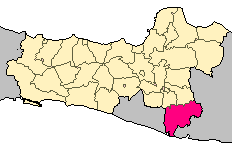
The Majapahit Empire was a thalassocracy in Southeast Asia, based on the island of Java, that existed from 1293 to circa 1500. Majapahit reached its peak of glory during the era of Hayam Wuruk, whose reign from 1350 to 1389 was marked by conquest which extended through Southeast Asia. His achievement is also credited to his prime minister, Gajah Mada. According to the Nagarakretagama (Desawarñana) written in 1365, Majapahit was an empire of 98 tributaries, stretching from Sumatra to New Guinea; consisting of present-day Indonesia, Singapore, Malaysia, Brunei, southern Thailand, Sulu Archipelago and East Timor, although the true nature of Majapahit sphere of influence is still the subject of studies among historians.

Nusantara is the Malayo-Polynesian name of Maritime Southeast Asia. It is a Javanese term which literally means "archipelago" in Old Javanese. In Indonesia it is generally taken to mean the Indonesian archipelago, while in Malaysia the term has been adopted to mean the Malay archipelago.

Gajah Mada was, according to Javanese old manuscripts, poems and mythology, a powerful military leader and Mahapatih or Prime Minister of the Indianized Hindu empire of Majapahit, credited with bringing the empire to its peak of glory. He delivered an oath called Sumpah Palapa, in which he vowed to live ascetic until he had conquered all of the Southeast Asian archipelago of Nusantara for Majapahit. In modern Indonesia, he serves as an important national hero, a symbol of patriotism and national unity. Due to their reign the Hindu epics, the Ramayana and the Mahabharata, became ingrained in the culture and worldview of the Javanese through the performing arts of wayang kulit.

Hayam Wuruk, also called Rajasanagara, Pa-ta-na-pa-na-wu, or Bhatara Prabhu, (1334–1389), was a Javanese Hindu King from the Rajasa Dynasty and the fourth monarch of the Indianised Majapahit Empire. Together with his prime minister Gajah Mada, he reigned the empire at the time of its greatest power. During his reign the Hindu epics, the Ramayana and the Mahabharata, became ingrained in the culture and worldview of the Javanese through the wayang kulit. He was preceded by Tribhuwana Wijayatunggadewi and succeeded by his son-in-law Wikramawardhana. Most of the accounts of his life were taken from Nagarakretagama and Pararaton.

Palapa is a series of communication satellites owned by Indosat, an Indonesian telecommunication company. All the satellites were launched by the United States, starting with the first in July 1976, at which time Indonesia became the first developing country to operate its own domestic satellite system.

Wonogiri is a regency in the southeastern part of Central Java province in Indonesia. It covers an area of 1,822.37 km2, and its population according to the latest estimate is 940,297, which is the 5th largest district in Central Java, as well as the largest regency in the former Surakarta Residency, and the largest regency that does not have the railway line in Central Java, and the 15th most populated district in Central Java, and the second largest in the former Surakarta Residency after Boyolali.

The National Museum of Indonesia, is an archeological, historical, ethnological, and geographical museum located in Jalan Medan Merdeka Barat, Central Jakarta, right on the west side of Merdeka Square. Popularly known as the Elephant Building after the elephant statue in its forecourt. Its broad collections cover all of Indonesia's territory and almost all of its history. The museum has endeavoured to preserve Indonesia's heritage for two centuries.
This article is about the architecture features of Banjar people of South Kalimantan, Indonesia. There are several types of traditional houses of the Banjarese:
- Bubungan Tinggi
- Gajah Baliku
- Gajah Manyusu
- Balai Laki
- Balai Bini
- Palimbangan
- Palimasan
- Anjung Surung
- Tadah Alas
- Rumah Lanting
- Joglo Gudang
- Bangun Gudang

Goa Gajah, or Elephant Cave, is located on the island of Bali near Ubud, in Indonesia. Built in the 9th century, it served as a sanctuary.

Persatuan Sepakbola Mojokerto Putra is a professional Indonesian football team based in Mojokerto Regency, East Java. Their homeground is Gajah Mada Stadium, Mojokerto. They compete in the Liga 2.
The Battle of Bubat also known as Pasunda Bubat is the battle between the Sundanese royal family and Majapahit army that took place in Bubat square on the northern part of Trowulan in 1279 Saka or 1357 CE. The uneven battle and the demonstration of courage through fighting an impossible battle and facing a certain death is in some ways similar to the Battle of Thermopylae.

Yunizar is an Indonesian artist. He was born in Talawi, West Sumatra, Indonesia. He graduated in 1999 with a degree in Fine Arts from Indonesian Institute of the Arts, Yogyakarta (ISI), a school of national pride and the heart of progressive art-making in Indonesia. Creativity and change are the forefront of the school's agenda and this is evident in Yunizar's work ethic. Yunizar's training reveals itself in his sophisticated expressive style, articulated through a playful composition and subtle palette. Executed primarily in acrylic and pencil, his works stand out in terms of texture, colour, brushwork and rhythm. A restrained palette of cool colours- yellows, browns and greens- is deliberately dirtied and smudged in his working and reworking of the canvas. The result is a highly tactile work that entices the viewer to feel the piece.

Sarik is a village in Dastgerdan Rural District, Dastgerdan District, Tabas County, South Khorasan Province, Iran. At the 2006 census, its existence was noted, but its population was not reported.

The Palapa oath was an oath taken by Gajah Mada, a 14th-century Prime Minister of the Javanese Majapahit Empire described in the Pararaton. In this oath Gajah Mada swore that he would not taste any spice, as long as he had not succeeded in unifying Nusantara. The oath was taken during his inauguration as Majapahit Amangkubhumi that took place in 1256 Saka (1334) or 1258 Saka (1336).

Gajah (Elephant) is the second studio album by Indonesian singer-songwriter Tulus. The album was released on February 19, 2014, by Demajors. The album occupied the eighth position in iTunes Indonesia in July. A few months after release, the single "Gajah" entered the charts in Indonesia. "Sepatu" had re-released single for Japanese' version "Kutsu" (セパトゥ〜くつ〜) and lyrically had translated by Hiroaki Kato, a Japanese artist. Other singles from the album were "1000 Tahun Lamanya" and "Jangan Cintai Aku Apa Adanya".
Muhammad Tulus, better known by his mononym Tulus, is an Indonesian singer-songwriter of Minangkabau descent.

Jalan Gajah Mada and Jalan Hayam Wuruk, formerly Molenvliet West and Molenvliet Oost respectively, is a major thoroughfare located in Jakarta, Indonesia. The two streets with its canal, the Batang Hari, connected Glodok and Kota Tua Jakarta to the north with Harmoni Junction to the south. Completed in late 1640s, the canal-street Gajah Mada and Hayam Wuruk is Jakarta's oldest major thoroughfare.

Gajah Mungkur Reservoir (Dam) is a water reservoir located at Pokohkidul in the Wonogiri Regency, Central Java, of Indonesia. It was constructed by redirecting the Bengawan Solo river, the longest in the Java Islands, that originates from The Gajah Mungkur Mountain. The maximum inundation area of Gajah Mungkur Reservoir is 88,000 hectares and covers the seven sub-districts of Wonogiri, Ngadirojo, Nguntoronadi, Baturetno, Giriwoyo, Eromoko, and Wuryantoro.
Taufik Hidayat is an Indonesian professional football player who currently plays as a Full-back for Liga 1 club PSM Makassar.

















